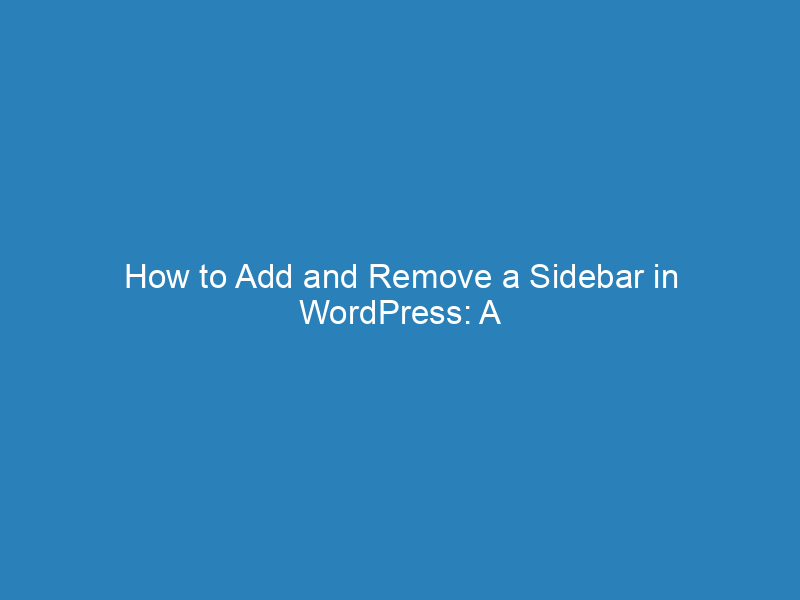
How to Add and Remove a Sidebar in WordPress: A Comprehensive Guide
Adding a sidebar in WordPress is a straightforward yet impactful way to enhance both the functionality and user experience of your website. Sidebars offer an organized space for various widgets, including recent posts, search bars, and custom menus, which facilitate easier navigation and access to content.
Why Are Sidebars Important?
Sidebars play a crucial role in website navigation and engagement. Here are several reasons why they matter:
- Quick Access: Sidebars provide immediate access to important sections, making it easier for visitors to explore your site.
- Highlight Content: They spotlight essential elements like recent posts or popular items, which can encourage user interaction.
- Encourage Engagement: By hosting interactive features, sidebars invite visitors to engage more deeply with your content.
- Boost Conversions: Strategically placed calls-to-action in sidebars can significantly increase conversion rates.
- Organized Layout: Sidebars help utilize your site’s layout efficiently, allowing for additional content without cluttering the main area.
How to Add a Sidebar in WordPress
Method 1: Using the WordPress Customizer
The WordPress Customizer is a user-friendly tool that allows you to add a sidebar without any coding knowledge. Follow these steps to get started:
- Log in to your WordPress dashboard and navigate to Appearance > Customize.
- Look for a section labeled Widgets or Sidebar, which may vary based on your theme.
- Click on the Widgets or Sidebar section, then select the area where you want to add the sidebar (e.g., Blog Sidebar, Footer Sidebar). Click on Add a Widget.
- Browse the list of available widgets and select the one you want to add. Customize the widget settings according to your needs.
- Preview your sidebar in real-time on the right side of the Customizer. Once you’re happy with the look and functionality, click Publish to make your changes live.
Method 2: Creating a Sidebar Through the Widgets Page
This method provides a more direct way to customize and add a sidebar. Here’s how:
- In your WordPress dashboard, click on Appearance > Widgets. You’ll see available widgets on one side and, if your theme supports it, sidebar areas on the other.
- Drag and Drop: Simply drag a widget from the available list into your chosen Sidebar area.
- Block Editor: If you are using WordPress 5.8 or newer, click the + button in the Sidebar area, find your widget, and add it.
- Click on your added widget to customize it, then hit Save or Update to keep your changes. To remove a widget, either select Delete or drag it out of the Sidebar.
- You can add as many widgets as you like. Preview your site to see how it appears and adjust as necessary.
Which Method Is Right for You?
Method 1: Using the WordPress Customizer
This method is ideal for:
- Beginners who prefer a straightforward, visual approach.
- Users needing to make quick changes with real-time previews.
- Websites requiring simple sidebar modifications without extensive customization.
Method 2: Creating a Sidebar Through the Widgets Page
This method is best suited for:
- Users familiar with WordPress who want greater control over their sidebar’s arrangement and content.
- Sites that require multiple sidebars or more complex configurations.
- Those comfortable navigating detailed settings without a live preview.
How to Remove a Sidebar in WordPress
Removing a Sidebar with the WordPress Customizer
- Access the Customizer by going to your WordPress dashboard, then selecting Appearance > Customizer.
- Locate the Widgets section, then select the specific sidebar you wish to remove.
- Open each widget by clicking the three dots icon, then select Delete to remove it from the sidebar preview.
- Continue this process for all widgets. Once all are cleared, the sidebar will no longer appear on your site.
Removing a Sidebar from the Widgets Page
- From the WordPress dashboard, select Appearance > Widgets.
- Open the Sidebar dropdown menu for the sidebar you wish to remove.
- Click on each widget and select Delete.
- Repeat until all widgets are removed. The sidebar will disappear from your site once all widgets are cleared.

